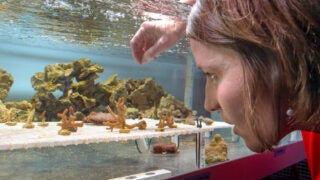USC Dornsife researchers join an international team to find underwater clues on how life bounced back after 90% of species died off.
Marine Biology
News Listing
To create a comprehensive inventory of marine species in Santa Catalina Island’s Blue Cavern Point nature preserve, USC scholars dived into kelp forests and came face-to-face with a great white shark.
Using a “kelp elevator,” researchers at the USC Wrigley Institute for Environmental Studies were able to grow the biofuel crop in large quantities in the open ocean.
USC scientists and their colleagues have developed a model that estimates two different ways microbes will respond to warming oceans.
Senior Connie Machuca studies corals and anemones to understand how they respond to rising temperatures, acidification and other ocean-related issues linked to climate change.
What USC researchers have uncovered about sea star locomotion could help scientists design simpler decentralized systems for all sorts of devices.
In oceans and lakes across the country, tiny organisms create big problems.
USC researchers have discovered that corals can pass on their reshuffled symbiotic algae, which may help their progeny withstand climate change.
Sharks aren’t just the apex predators we see in movies; they’re complicated, fascinating creatures that Trojans are investigating from many angles.
New research by USC scientists shows domoic acid from ocean algae is a chronic problem with natural and man-made origins.









